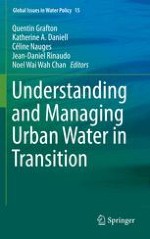2015 | OriginalPaper | Chapter
14. Non-household Water Demand: The Industrial and Commercial Sectors
Author : Steven Renzetti
Published in: Understanding and Managing Urban Water in Transition
Publisher: Springer Netherlands
Activate our intelligent search to find suitable subject content or patents.
Select sections of text to find matching patents with Artificial Intelligence. powered by
Select sections of text to find additional relevant content using AI-assisted search. powered by
